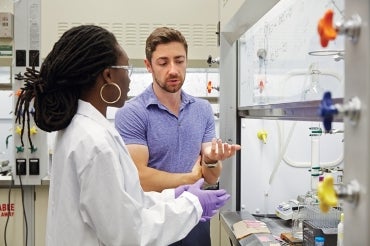‘Exquisitely tailored’ molecules – made at U of T – hold great promise for deadly ignored cancers, says researcher Patrick Gunning

Published: February 24, 2017
U of T professor Patrick Gunning is at the forefront of a tectonic shift in the fight against cancer. As head of the new Centre for Medicinal Chemistry, his research may well halt some of the deadliest and rarest forms of the disease, including cancers of the blood, brain and breast.
Unlike healthy cells, cancer cells constantly grow and divide, evading natural cues to die. Gunning is killing cancer cells by blocking the key proteins necessary for their survival. His research targets the STAT3 and STAT5 proteins, which play a role in 70 per cent of cancers. Gunning has created molecules that “switch off” these proteins, severing cancer’s lifeline. What’s more, healthy cells are untouched.
Four potential new drugs are in the final stages of development. “We’re almost there,” says Gunning. “Our molecules have killed cancer cells in numerous pre-clinical trials. Now we need to get them into clinical trials, so we can start saving lives.”
What is your area of research?
I do medicinal chemistry and drug discovery. Simply put, it is the design and synthesis of molecules that target proteins that drive the cancer cell. The objective is if we bind potently and selectively to that protein, we inhibit its function and the ultimate result of that interaction is that the cancer cell dies.
We’ve been focusing on designing molecules that target STAT3 and STAT5 [proteins], which are known to be major players in cancer. In fact, they’re hyper activated in 70 per cent of all human cancers so there’s . . . a lot of interest in trying to inhibit them in cancer cells.
That’s been the major thrust of my research but we look at other targets, as well, in different diseases such as psoriasis and multiple sclerosis.
What makes what you’re doing different from the tens of thousands of researchers around the globe who are trying to put an end to cancer?
There are similarities in what we do. But we’ve tried to focus on targets that people consider to be undruggable. Up until a couple of years ago, STAT3 was considered undruggable. The properties of the protein were such that it wasn’t thought that conventional drug discovery could be utilized to make molecules to target that protein.
We also go after orphan diseases – diseases that have no cure and where the population of patients is very small, where there’s only 300 patients in all of North America a year.
From a commercial aspect, they are not the most appealing to pharmaceutical companies because the potential [monetary] returns on the drug are not as big as in a much larger cancer field like breast cancer.
We try to go after targets that are not low-hanging fruit. They’re hard and challenging. That’s our remit in academia to see if we can make novel and innovative molecules that bring these targets to light.
Why is taking a targeted-molecule approach to cancer better than existing treatments like chemotherapy?
The idea is that we make molecules that are exquisitely tailored to a specific target. If you have this type of incisive knockout of a particular target, there’s hopefully less side effects. General chemotherapy and radiation tend not to be selective. As a result, you have general toxicity in the human body. With targeted therapeutics, you hit fewer things and . . . it’s a much softer treatment.
So this is better for the patient and the health-care system in terms of cost?
Well, this is it exactly. Ultimately, we’re going to come to a stage where the norm is that cancers are identified by the proteins that drive them, rather than the organ the tumour is associated with. That means patients will be treated with more targeted therapeutics. Ultimately, that therapy should therefore be more effective.
What is it that drew you to this type of work?
What drew me to cancer research was my postdoc studies. I was never meant to do this. I was meant to be in supramolecular chemistry. But my supervisor essentially said, ‘This is the medicinal chemistry project you’re doing,’ . . . and I loved it.
I made molecules targeting breast cancer, and the molecules killed breast cancer cells selectively over healthy cells. That was just such a rewarding moment for me. I knew that this was what I really wanted to do as a career.
I next went after brain cancer. My grandmother died of brain cancer – it’s a very poorly treated cancer. That was a real motivation. My interactions with brain cancer scientists led me to recurrent medulloblastoma, a treatment-resistant children’s brain cancer. It has a huge unmet clinical need so that was a natural progression of this work.
The other field [I work in] is targeting acute myeloid leukemia, which is a really aggressive blood cancer that’s typically found in elderly patients. The current aggressive chemotherapy is too toxic for frail patients to withstand. The need for softer therapeutics in the AML field is really quite high.
You mentioned that you have something in advanced preclinical trial. Can you tell us about that?
We’ve got a recurrent medulloblastoma cancer drug going into advanced preclinical trials right now. It targets STAT3 and STAT5. This molecule is one of the most potent AML drugs that we’ve seen in our hands.
We’re on the clinical path now which is quite nice for an academic. For us, reaching this point is symbolic. We’re actually doing something worth investing millions of dollars in. It’s really a validation of what we’re doing.
[Conducting advanced preclinical trials requires millions of dollars and sees the drug tested in dogs for cardio toxicity, pigs and primates for neurotoxicity. Testing usually takes a year. If the drug is successful, phase 1 trials will take place, which require testing the drug in approved human patients. This testing will require millions more in funding and years of study. Only when the drug is successful at this stage – and there is no guarantee – is it deemed safe for the public.]
What does the molecule look like?
It’s super pretty. I’m being serious.
For your medulloblastoma cancer drug, if the trials are a success, when do you see it being available to people?
The molecule has moved into advanced preclinical and could be in humans [for Phase 1 testing] within a year and a half to two years – if it meets all of its milestones in terms of toxicity [at the advanced preclinical stage]. If it keeps on working, it could be available to recurrent medulloblastoma cancer patients within three to four years.
I think the public doesn’t realize that there are many hurdles in the drug discovery pipeline that can lead to a project being cancelled. For example, in trials, testing could uncover that the drug causes heart problems and as a result, the whole project would be dead in one go. It’s very cutthroat.
Do you have others close to being ready for preclinical trial?
We’ve got several [preclinical] trials running right now on different molecules, HDAC, UBA5 and ROS1. We’ve got lots! If they work optimally, we’ll be at the stage to go to advanced preclinical. If they don’t, we’ll have to go back to the drawing board and optimize them a wee bit more using chemistry before we go into preclinical trials again and then hopefully to advanced preclinical trials.
You often travel and speak about your research on behalf of U of T around the globe. What are some of the most surprising questions you receive from the audience?
The most common one is, ‘When is this going to become available?’ I think a lot of people are really interested because their relatives or friends who are suffering from cancer and want to know when these new therapies can be accessed to help them. A lot of people are just happy that we and many others like us, are trying [to find better treatments].
What is it about being at U of T that makes this research possible for you?
U of T has been incredibly supportive.
Right now, we’re building the Centre for Medicinal Chemistry at U of T Mississauga, thanks to a $7-million donation by the Orlando Corporation. This facility will be a one-stop shop for developing advanced preclinical [drug] candidates.
The university has been great at building infrastructure for someone like me to get to a stage where we can do, to a certain extent, what industry can do when it comes to drug discovery. But we want to take it a step further. We want to have an entire centre that can do this!
I’m really excited because we’re going to have in place all of the facilities to run preclinical trials in-house and more rapidly identify compounds that should be further down the clinical pathway.
Where are your clinical trials currently taking place? When will this centre be operational?
Right now, the preclinical trials are not done in-house. They’re all done with collaborators. That’s great, but it’s a much slower process. The goal is to have the centre built in late 2019.
What are the next big advances you want to go after in medicinal chemistry?
With the centre in place, we’ll be able to test more compounds [and find] molecules that have great potential. Right now, we don’t have the resources or infrastructure to test them all.
Patrick Gunning is the Canada Research Chair in Medicinal Chemistry at the University of Toronto Mississauga. His cancer research is just one example of extraordinary impact at U of T. Learn more at utoronto.ca



